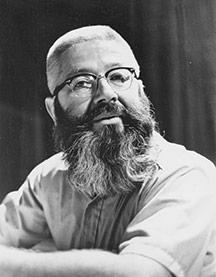
IRIS login | Reed College home Volume 92, No. 4: December 2013
Apocrypha: Traditions, Myths, & Legends
The Prison of Memory
By Laurie Lindquist

Beggars, many of them children, pulled at our clothes as we marched through, rubbing their stomachs and thrusting their fingers into empty mouths to pantomime their hunger . . . Naples was a premonitory mirage—a stage setting for a drama that had yet to begin. Here, as prelude, was a vision of the aftermath of war. The thing itself lay coiled and waiting somewhere on the road ahead.
With these words, Prof. Seth Ulman [English & theatre 1959–73] sends forth a crew of greenhorn army medics into the battleground of Italy in Prisoners of War, a fictionalized memoir that he completed in 1986 but never published.
Prisoners of War begins in 1942, a year after the Japanese attack on Pearl Harbor, when a cadre of “misfits”—lacking the survival instincts essential to a soldier on the front line—arrive in camp for basic training. Each of the men, “the most heterogeneous collection of inexperience and innocence that anyone could well imagine,” are mad for distraction and some sense of normalcy amid the chaos of war. On the face of one man, F_, with its youthful uncertainty, Ulman sees “something tense and untested.” It is a symptom of the time, he says, and it becomes an “unfinished question” that he refers to many times in Prisoners. Ulman leads his medics away from the dusty plains of Oklahoma to the rain-soaked, bombed-out rubble of Naples, scraped down to the bone and resembling “some evil hallucination.” He sends them onward through towns and mountain passes, facing want and danger, to the Battle of Monte Cassino, where they tend wounded soldiers who arrive for aid on a steady stream of litters.
What he confronts in Prisoners is the way in which war steals a soldier’s life, long before death takes it—but also how one may break free of the weight of grief, for a time at least, by making a conscious choice to do so.
Ulman graduated summa cum laude in English from UC Berkeley in 1942 and joined the U.S. Army. He was with his platoon in Rome on June 4, 1944, when the city was liberated from the Nazis. “I remember the gates opening, streams of soldiers coming through. I saw German snipers in the windows of apartment buildings and frantic women throwing themselves on top of my Jeep, men ripping rose bushes out of the ground and hurling the flowers in the air.”
Following the war, he returned to Berkeley, where he completed a PhD and taught English and dramatic arts before attending a two-year Fulbright fellowship in Japan.
During his tenure at Reed, Ulman served as head of the theatre department, directing semester and summer productions and lecturing in the community. “Seth’s one-person theatre department was a very active one,” says Prof. Tom Dunne [chemistry 1963–95]. “Wonderful productions were followed, in some cases, by captivation toward outstanding careers in theatre.” Storyteller Cricket Parmalee ’67, who received the Class of ’21 Award for her work in theatre, says: “I never met anyone who cared more, thought more, about the text than Mr. Ulman. He knew many languages, and would refer back to the original to get the nuance of the playwright’s meaning.”
Ulman survived dysentery, terror, and artillery fire, he tells his reader in Prisoners, by willing himself to live. After Reed, he retired to Monterey, California, and died in 2000, following an extended struggle with cancer.
![]()
Ulman’s portrait of war inspired several champions, including Prof. Sam Danon [1962–2000], Prof. Nick Wheeler ’55 [physics, 1963–2010], archivist Gay Walker ’69, and Prof. Gary Miranda [creative writing 1979–87]. But for one reason or another, the manuscript was never published and remains in the Hauser Library among the Seth Ulman Papers, presented to the college by his daughter Alison in 2004. The papers fill 16 boxes and contain everything from correspondence to production notes and playbills—some bearing singe marks from the fire that burned down the Reed theatre in 1969. The papers are part of 40 manuscript collections—find a complete list in the Reed Library Special Collections.

LATEST COMMENTS
steve-jobs-1976 I knew Steve Jobs when he was on the second floor of Quincy. (Fall...
Utnapishtim - 2 weeks ago
Prof. Mason Drukman [political science 1964–70] This is gold, pure gold. God bless, Prof. Drukman.
puredog - 1 month ago
virginia-davis-1965 Such a good friend & compatriot in the day of Satyricon...
czarchasm - 4 months ago
John Peara Baba 1990 John died of a broken heart from losing his mom and then his...
kodachrome - 7 months ago
Carol Sawyer 1962 Who wrote this obit? I'm writing something about Carol Sawyer...
MsLaurie Pepper - 8 months ago
William W. Wissman MAT 1969 ...and THREE sisters. Sabra, the oldest, Mary, the middle, and...
riclf - 10 months ago